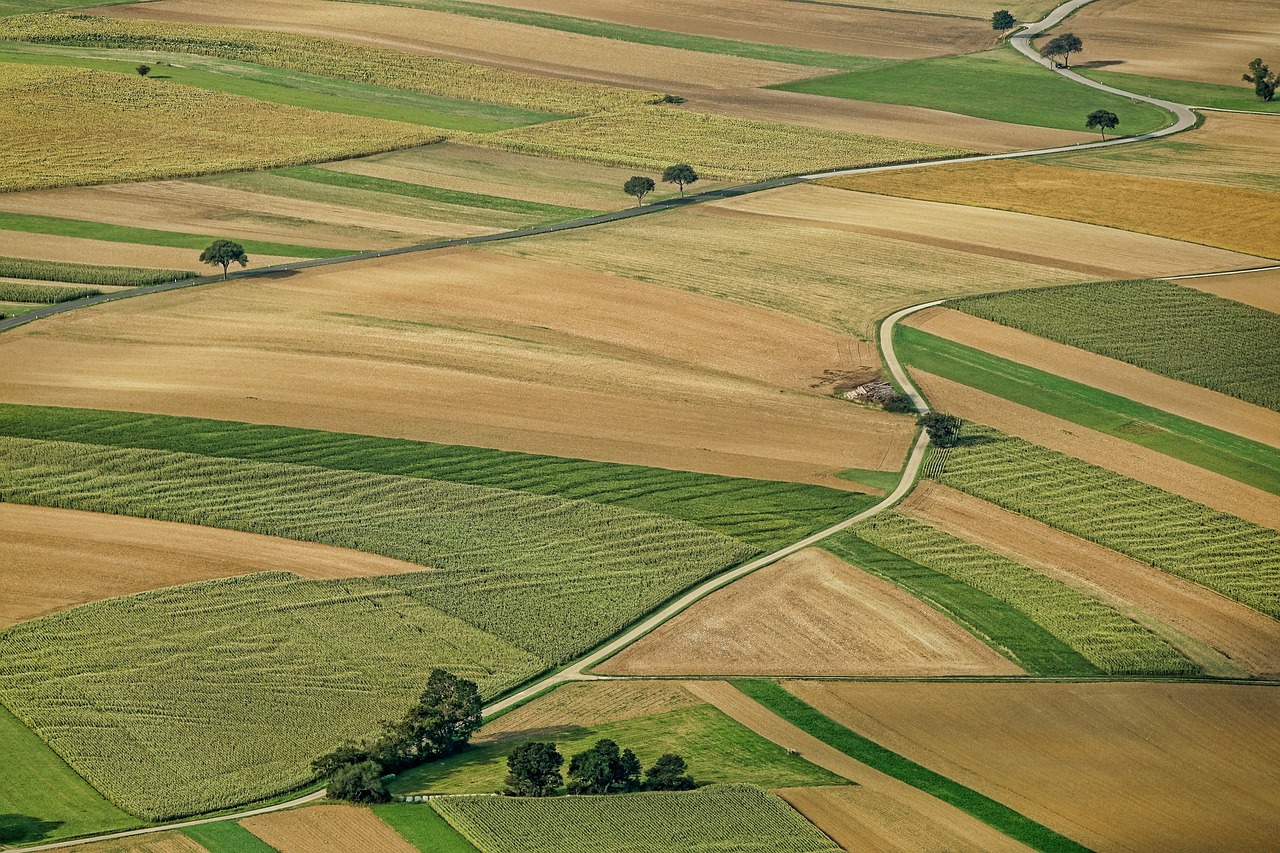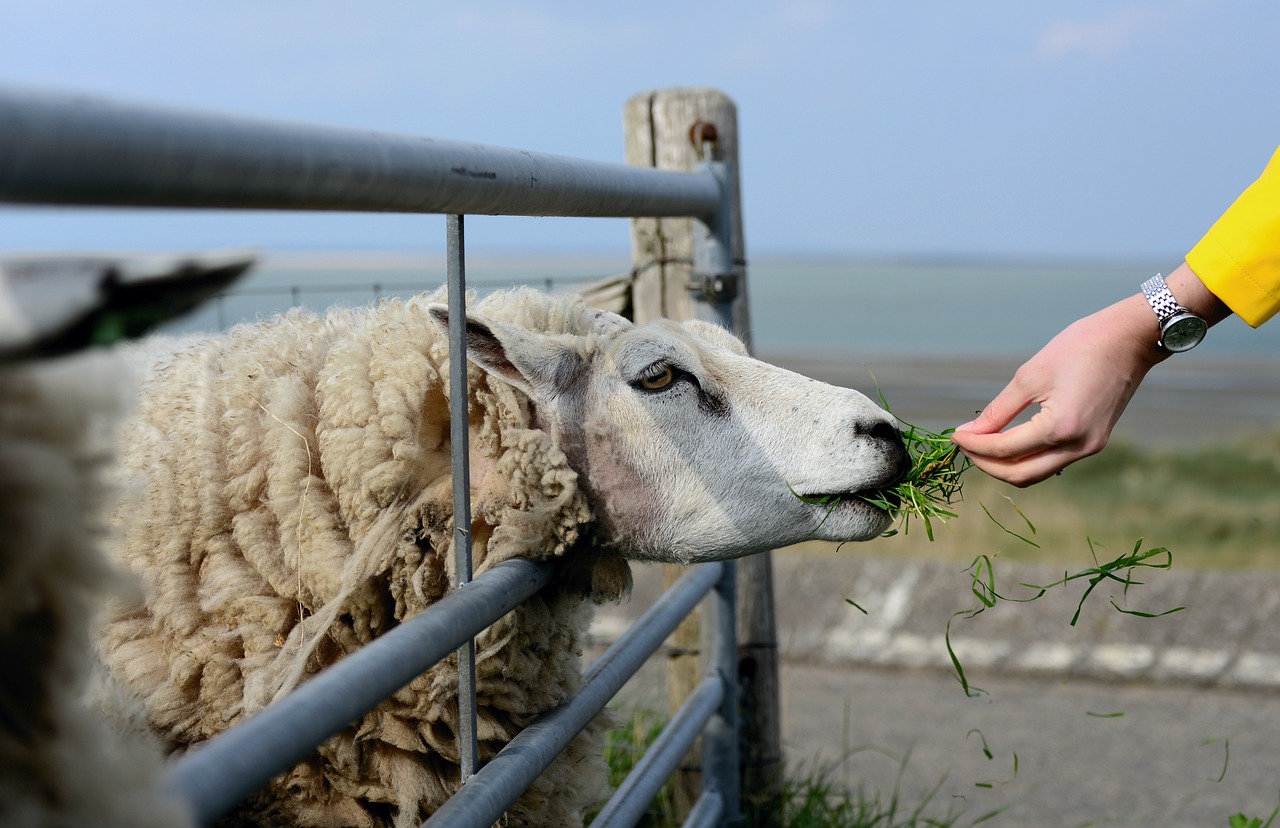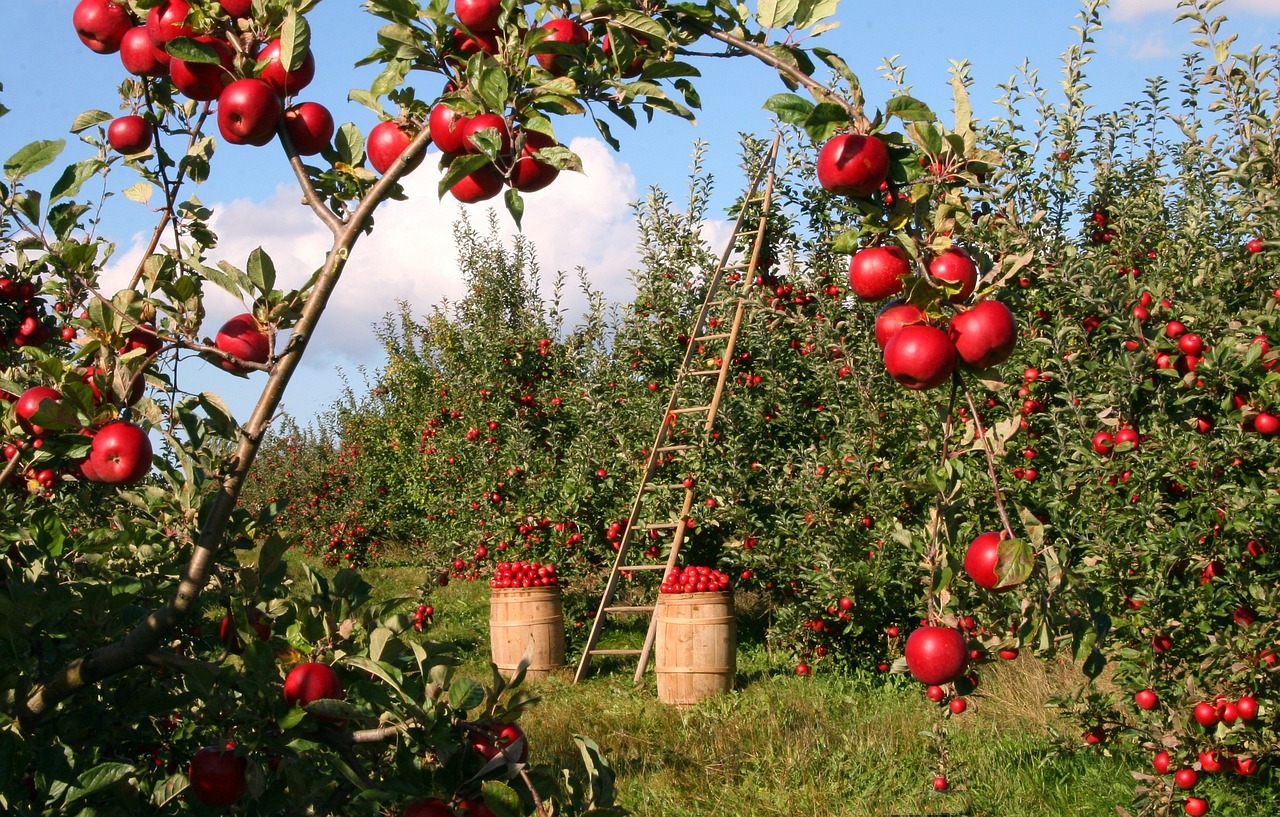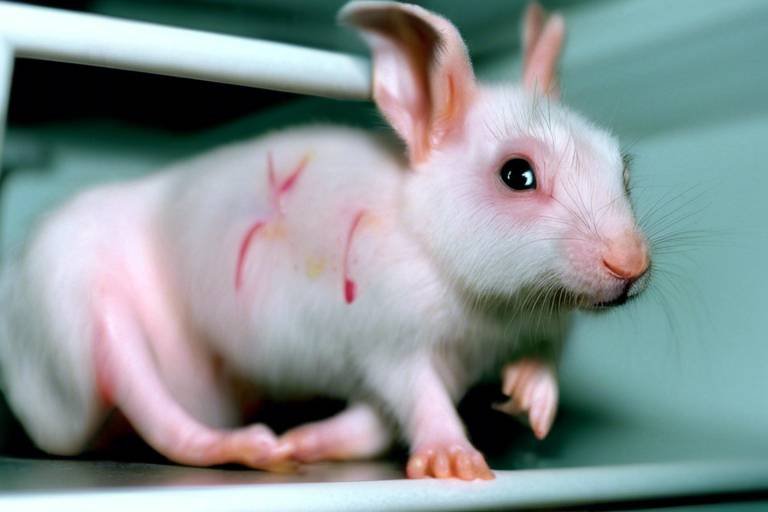Analyzing the Environmental Ethics of Animal Agriculture
The relationship between animal agriculture and environmental ethics is a complex and multifaceted topic that touches on various critical issues, including ecosystem health, animal welfare, and sustainable practices. As we navigate through the 21st century, the impact of our food systems on the planet has become increasingly apparent. Have you ever stopped to think about where your food comes from and the implications of that source? The choices we make regarding animal agriculture can significantly affect our environment, our health, and the lives of countless animals. This article delves into the intricate dynamics of animal agriculture, exploring its environmental consequences while also addressing the moral responsibilities we hold as consumers and producers.
When we talk about the environmental impact of animal agriculture, we're diving into a vast ocean of issues. From land use to greenhouse gas emissions, the consequences of raising animals for food are profound. Did you know that animal agriculture is responsible for nearly 15% of global greenhouse gas emissions? This staggering statistic highlights the urgent need for sustainable practices in farming. Moreover, the land required for livestock farming and feed production often leads to deforestation, habitat loss, and a decline in biodiversity. All of these factors contribute to the ongoing crisis of climate change, making it crucial for us to assess the sustainability of these practices.
The ethical considerations surrounding animal agriculture are equally pressing. How do we justify the treatment of animals raised for food? This question is not just about animal rights; it’s about our moral responsibilities as stewards of the planet. Many consumers are becoming increasingly aware of the conditions in which livestock are raised, leading to a demand for more humane practices. As we ponder this dilemma, it's essential to recognize that the welfare of these animals is intertwined with environmental health. After all, happy and healthy animals can contribute to more sustainable farming practices. The challenge lies in finding a balance between food production and ethical treatment.
Implementing sustainable farming practices is a vital step toward reducing the ecological footprint of animal agriculture. Techniques such as rotational grazing and integrated pest management not only promote animal welfare but also enhance environmental health. For instance, rotational grazing allows livestock to graze in a manner that promotes soil regeneration and reduces overgrazing. This method can lead to healthier pastures and improved biodiversity. Similarly, integrated pest management minimizes the use of harmful chemicals, benefiting both the environment and the animals. These practices demonstrate that it is possible to produce food while also caring for the planet.
One exciting approach gaining traction is regenerative agriculture. This method goes beyond sustainability by actively restoring ecosystems while producing food. Imagine a farming system that not only feeds us but also enhances soil health and boosts biodiversity! Regenerative agriculture focuses on practices that improve the land, such as cover cropping, no-till farming, and agroforestry. These techniques can help sequester carbon in the soil, combat climate change, and create a more resilient food system. By adopting regenerative practices, farmers can contribute to both environmental restoration and animal welfare, creating a win-win situation for all.
The debate between organic and conventional farming is another crucial aspect of animal agriculture ethics. While both methods aim to produce food, they differ significantly in their approaches and impacts. Organic farming typically prohibits the use of synthetic pesticides and fertilizers, promoting a more natural ecosystem. This approach often results in better animal welfare standards and less environmental degradation. On the other hand, conventional farming may prioritize higher yields and lower costs but can lead to detrimental effects on animal welfare and the environment. Understanding these differences can empower consumers to make informed choices that align with their values.
As consumers, we wield considerable power in shaping the animal agriculture industry. Our choices can either support sustainable practices or perpetuate harmful ones. By opting for products that prioritize animal welfare and environmental sustainability, we can drive demand for ethical farming practices. Informed choices are crucial; they can lead to significant changes in the industry. For example, when consumers choose to buy from local farms that practice humane treatment of animals or support brands committed to sustainable sourcing, they contribute to a more ethical food system. It’s like casting a vote with your wallet—every purchase matters!
Government policies and regulations play a pivotal role in shaping the practices of animal agriculture. Effective frameworks can encourage sustainable practices and protect animal welfare. However, the current landscape is often riddled with loopholes and inadequate enforcement. Analyzing existing policies and advocating for reforms is essential for fostering a more ethical and sustainable food system. By pushing for stricter regulations on animal welfare and environmental impact, we can ensure that animal agriculture evolves in a way that benefits both the planet and its inhabitants.
Global cooperation is vital in addressing the environmental ethics of animal agriculture. International standards and agreements can help harmonize practices across borders, promoting sustainability and animal welfare on a global scale. By working together, countries can share best practices, technologies, and innovations that lead to better outcomes for both animals and the environment. This collaborative effort is essential for tackling the challenges posed by climate change and food security, highlighting the interconnectedness of our global food system.
While global efforts are crucial, local initiatives can spark significant change in animal agriculture practices. Communities around the world are stepping up to promote ethical farming and environmental stewardship. From farmers' markets that prioritize local, humane products to community-supported agriculture (CSA) programs that connect consumers directly with farmers, grassroots efforts are making a difference. These initiatives not only support local economies but also foster a deeper connection between consumers and their food sources, encouraging more sustainable choices.
- What is the environmental impact of animal agriculture?
Animal agriculture contributes significantly to greenhouse gas emissions, deforestation, and biodiversity loss. - How can consumers promote ethical animal agriculture?
By choosing products that prioritize animal welfare and sustainable practices, consumers can drive demand for ethical farming. - What are sustainable farming practices?
Sustainable practices include rotational grazing, integrated pest management, and regenerative agriculture, all aimed at reducing environmental impact. - What is the difference between organic and conventional farming?
Organic farming avoids synthetic chemicals and promotes animal welfare, while conventional farming often prioritizes higher yields at the expense of sustainability.

The Environmental Impact of Animal Agriculture
Animal agriculture is a major player in the environmental landscape, impacting our planet in ways that are often overlooked. When we think about farming, we might envision picturesque fields and happy cows grazing under the sun, but the reality is far more complex. The industry significantly influences land use, water resources, and greenhouse gas emissions. Understanding these impacts is crucial for assessing its sustainability and ethical implications, especially in the context of climate change.
To put things into perspective, let's consider some statistics that highlight the scale of animal agriculture's impact:
| Impact Area | Statistics |
|---|---|
| Land Use | Animal agriculture occupies about 77% of global agricultural land. |
| Water Usage | It takes approximately 1,800 gallons of water to produce just one pound of beef. |
| Greenhouse Gas Emissions | Livestock production is responsible for about 14.5% of global greenhouse gas emissions. |
These figures might seem shocking, but they underline a critical point: the way we raise animals for food has profound effects on our environment. The conversion of forests into pastureland, for example, not only leads to habitat loss for countless species but also contributes to increased carbon emissions as trees that once absorbed CO2 are cut down. This cycle of destruction is a pressing concern in an era where climate change is a looming threat.
Moreover, the demand for animal products drives intensive farming practices that often result in soil degradation and water pollution. Manure runoff can contaminate local waterways, leading to harmful algal blooms that threaten aquatic life and human health. It’s a vicious cycle that raises important questions: Are we sacrificing our environment for the sake of convenience and tradition? What can be done to mitigate these effects?
Interestingly, consumers can play a pivotal role in addressing these issues. By choosing sustainably sourced animal products, or even reducing meat consumption, individuals can contribute to a shift towards more environmentally friendly practices. It's about making informed choices that prioritize environmental health alongside our dietary preferences. After all, every bite we take can either support or undermine the health of our planet.
In conclusion, the environmental impact of animal agriculture is a multifaceted issue that demands our attention. As we navigate the complexities of food production and consumption, it’s essential to consider not just the immediate benefits of animal products, but also their long-term effects on our ecosystems. By fostering a deeper understanding of these impacts, we can work towards a more sustainable and ethical approach to animal agriculture.
- What are the main environmental concerns associated with animal agriculture? The main concerns include land degradation, water pollution, and greenhouse gas emissions.
- How can consumers make a difference? By choosing sustainably sourced products and reducing meat consumption, consumers can encourage more ethical farming practices.
- What are some sustainable farming practices? Practices like rotational grazing and integrated pest management can help reduce the ecological footprint of animal agriculture.

Animal Welfare and Ethical Considerations
When we think about animal agriculture, it's impossible to ignore the profound ethical questions it raises. Animals are not just products; they are sentient beings capable of experiencing pain, joy, and everything in between. The way we treat these animals reflects our values as a society. Are we prioritizing profit over compassion? Are we turning a blind eye to suffering in the name of food production? These questions are not just philosophical; they are deeply rooted in our daily choices and actions.
One of the most pressing issues in animal agriculture is the conditions in which animals are raised. Factory farming, for instance, often leads to overcrowding, lack of proper veterinary care, and minimal space for animals to express natural behaviors. This raises the question: what does it mean to raise animals ethically? To answer this, we must consider the Five Freedoms of animal welfare, which include:
- Freedom from hunger and thirst
- Freedom from discomfort
- Freedom from pain, injury, or disease
- Freedom to express normal behavior
- Freedom from fear and distress
These freedoms establish a baseline for the ethical treatment of animals. However, merely adhering to these principles is not enough. We must also examine the broader implications of our choices. For example, the demand for cheap meat often leads to practices that compromise animal welfare. In a world where consumers are increasingly aware of these issues, there is a growing movement advocating for more humane treatment of farm animals.
Moreover, the ethical considerations extend beyond just the animals themselves. They encompass the environmental impact of animal agriculture and how it affects communities. Poor animal welfare practices can lead to soil degradation, water contamination, and increased greenhouse gas emissions. This creates a cycle of harm that affects not only the animals but also the planet and future generations.
As consumers, we wield significant power in shaping the industry. Our choices can either support or challenge these harmful practices. By opting for products from farms that prioritize animal welfare, we send a clear message that we value ethical treatment. This can be as simple as choosing grass-fed beef or free-range eggs, which often come from farms that adhere to higher welfare standards.
In conclusion, the ethical considerations surrounding animal agriculture are complex and multifaceted. They challenge us to reflect on our values and the impact of our choices. By advocating for better treatment of animals and supporting sustainable practices, we can contribute to a more ethical and responsible food system. After all, the way we treat animals is a reflection of our humanity.
Q1: What are the Five Freedoms of animal welfare?
A1: The Five Freedoms are a set of principles that outline the basic welfare needs of animals, including freedom from hunger, discomfort, pain, fear, and the freedom to express normal behaviors.
Q2: How can consumers support animal welfare?
A2: Consumers can support animal welfare by choosing products from farms that prioritize humane treatment, such as organic or free-range options, and by advocating for better practices in the industry.
Q3: What impact does animal agriculture have on the environment?
A3: Animal agriculture can significantly impact the environment through land degradation, water pollution, and greenhouse gas emissions, which contribute to climate change.
Q4: Are there certifications for humane animal treatment?
A4: Yes, there are various certifications, such as Certified Humane and Animal Welfare Approved, that indicate higher welfare standards in animal agriculture.

Sustainable Farming Practices
Sustainable farming practices are not just a trend; they are a necessity for the future of our planet. Imagine walking through a lush, green pasture where animals roam freely, and the air is fresh and clean. This idyllic scene is not just a dream; it can be a reality if we adopt practices that prioritize the health of our ecosystems alongside the welfare of animals. By implementing sustainable methods, farmers can reduce their ecological footprint while still meeting the growing demand for food.
One of the cornerstones of sustainable farming is rotational grazing. This method involves moving livestock between different pastures, allowing the land to recover and regenerate. Think of it as giving the earth a much-needed break, similar to how we might take a vacation to recharge our batteries. This practice not only improves soil health but also enhances biodiversity by allowing various plant species to flourish. When animals graze in a controlled manner, they help to aerate the soil and promote nutrient cycling, which ultimately leads to healthier ecosystems.
Another effective approach is integrated pest management (IPM). This strategy combines biological, cultural, and chemical practices to manage pests in an environmentally friendly way. Instead of relying solely on harmful pesticides, farmers can use natural predators or introduce crop rotation to disrupt pest life cycles. Imagine having a garden where ladybugs and other beneficial insects thrive, keeping harmful pests at bay without the need for toxic chemicals. This not only protects the environment but also ensures that the food we consume is safer and healthier.
Moreover, sustainable farming practices often emphasize the importance of crop diversity. By planting a variety of crops, farmers can create a more resilient agricultural system. This diversity acts like a safety net; if one crop fails due to disease or adverse weather, others can still thrive. It’s akin to having a diversified investment portfolio—spreading the risk can lead to more stable returns. Additionally, diverse crops can improve soil health and reduce the need for synthetic fertilizers, which can have detrimental effects on water quality.
Incorporating agroforestry into farming systems is another promising practice. By integrating trees and shrubs into agricultural landscapes, farmers can enhance biodiversity, improve soil structure, and sequester carbon. Picture a farm where fruit trees provide shade for livestock while also yielding delicious produce. This symbiotic relationship not only boosts productivity but also contributes to a more sustainable and balanced ecosystem.
Ultimately, the transition to sustainable farming practices requires a shift in mindset—from viewing agriculture solely as a means to produce food to seeing it as a holistic system that interacts with the environment. Farmers, consumers, and policymakers must work together to promote these practices, ensuring a healthier planet for future generations. By making informed choices and supporting sustainable agriculture, we can all play a part in this vital transformation.
- What are sustainable farming practices? Sustainable farming practices are methods that aim to produce food while preserving environmental health, promoting animal welfare, and ensuring economic viability.
- How does rotational grazing benefit the environment? Rotational grazing improves soil health, enhances biodiversity, and reduces the risk of overgrazing by allowing pastures to recover.
- What is integrated pest management? Integrated pest management is a strategy that uses a combination of biological, cultural, and chemical practices to manage pests in an environmentally friendly way.
- Why is crop diversity important? Crop diversity helps create a resilient agricultural system, reduces the risk of crop failure, and improves soil health.
- How does agroforestry contribute to sustainability? Agroforestry integrates trees and shrubs into agricultural systems, enhancing biodiversity, improving soil structure, and sequestering carbon.

Regenerative Agriculture
Regenerative agriculture is more than just a buzzword in the farming community; it represents a profound shift in how we think about food production and its relationship with the environment. Imagine a farming system that not only produces food but also actively restores the health of the ecosystem. This approach emphasizes working with nature rather than against it, aiming to enhance soil fertility, increase biodiversity, and improve water cycles. By focusing on regenerative practices, farmers can create a positive feedback loop that benefits both the land and the animals that inhabit it.
At its core, regenerative agriculture seeks to heal the planet. Traditional farming methods often deplete soil nutrients and contribute to environmental degradation, but regenerative practices aim to reverse these trends. Techniques such as cover cropping, no-till farming, and agroforestry play a crucial role in this process. For instance, cover crops can prevent soil erosion, enhance soil structure, and increase organic matter, which in turn improves soil fertility. This is akin to giving the earth a nutrient-rich meal, allowing it to thrive and support diverse forms of life.
Moreover, regenerative agriculture places a strong emphasis on biodiversity. By integrating a variety of crops and livestock, farmers can create a more resilient ecosystem. This diversity not only helps to control pests naturally but also enhances the nutritional value of the food produced. Think of it as a well-balanced diet for the farm itself, where different species contribute to a harmonious and productive environment. In this way, regenerative practices can lead to healthier animals, which in turn produce higher-quality food for consumers.
One of the most exciting aspects of regenerative agriculture is its potential to sequester carbon. By improving soil health, regenerative practices can capture carbon dioxide from the atmosphere and store it in the soil. This process is crucial in the fight against climate change, as it helps reduce greenhouse gas emissions. To illustrate this point, consider the following table that summarizes the benefits of regenerative agriculture:
| Benefit | Description |
|---|---|
| Soil Health | Increases organic matter and soil fertility. |
| Biodiversity | Promotes a diverse range of crops and livestock. |
| Carbon Sequestration | Helps capture and store atmospheric carbon in the soil. |
| Water Management | Improves water retention and reduces runoff. |
In conclusion, regenerative agriculture embodies the idea that we can produce food while simultaneously nurturing our planet. It challenges the conventional practices that have led to ecological harm and offers a hopeful alternative that aligns with ethical considerations regarding animal welfare and environmental stewardship. As consumers, supporting regenerative agriculture is not just a choice; it’s a commitment to a sustainable future where food production and environmental health go hand in hand.
- What is regenerative agriculture? Regenerative agriculture is a farming approach that focuses on restoring and enhancing the health of ecosystems while producing food.
- How does regenerative agriculture benefit the environment? It improves soil health, increases biodiversity, sequesters carbon, and enhances water management.
- Can consumers support regenerative agriculture? Yes, consumers can support regenerative practices by choosing products from farms that prioritize sustainability and ethical treatment of animals.
- What are some common practices in regenerative agriculture? Common practices include cover cropping, no-till farming, crop rotation, and agroforestry.

Organic vs. Conventional Farming
The debate between organic and conventional farming is as lively as a farmer's market on a sunny Saturday morning. At first glance, it might seem like a simple choice between two methods of food production, but the implications run much deeper. Organic farming is often touted as the more environmentally friendly option, emphasizing practices that promote sustainability and animal welfare. In contrast, conventional farming typically focuses on maximizing yields and efficiency, sometimes at the expense of the environment and animal rights.
To truly understand the differences, let's break down some key aspects:
| Aspect | Organic Farming | Conventional Farming |
|---|---|---|
| Pesticides and Fertilizers | Uses natural alternatives, promoting biodiversity | Relies on synthetic chemicals for higher yields |
| Animal Welfare | Prioritizes humane treatment and access to pasture | Often involves confinement and limited space |
| Soil Health | Focuses on building healthy, nutrient-rich soils | May lead to soil degradation due to monoculture practices |
| Environmental Impact | Generally lower carbon footprint and enhanced biodiversity | Can contribute to pollution and habitat loss |
While organic farming promotes practices that are kinder to the planet and its inhabitants, it often comes with a higher price tag. This can create a dilemma for consumers who want to support ethical farming but may find organic options out of reach. On the other hand, conventional farming, while efficient, raises questions about the true cost of food production—both in terms of environmental degradation and animal suffering.
One of the most significant ethical considerations in this debate is the treatment of animals. In organic systems, animals are typically given more space and access to the outdoors, which allows them to engage in natural behaviors. This is not merely a luxury but a fundamental aspect of their well-being. In contrast, conventional farming practices often prioritize production over animal welfare, leading to conditions that many would consider inhumane.
Moreover, the choice between organic and conventional farming extends beyond personal preference; it reflects broader societal values. As consumers become more aware of the environmental and ethical implications of their food choices, they are increasingly seeking transparency and sustainability in the agricultural practices behind their meals. This shift in consumer demand is encouraging some conventional farmers to adopt more sustainable practices, blurring the lines between the two methods.
Ultimately, the choice between organic and conventional farming is not just about the food on your plate; it's about the kind of world you want to support. By understanding the implications of each method, consumers can make informed decisions that align with their values, promoting a more sustainable and ethical food system.
- What is the main difference between organic and conventional farming?
Organic farming focuses on natural processes and sustainability, while conventional farming often relies on synthetic chemicals and high-yield practices. - Are organic foods healthier than conventional foods?
While organic foods may have fewer pesticide residues, the health benefits can vary. It's essential to consider overall diet and lifestyle. - How does animal welfare differ between organic and conventional farming?
Organic farming typically provides better living conditions for animals, allowing them more space and access to outdoor environments. - Can conventional farmers adopt sustainable practices?
Yes, many conventional farmers are incorporating sustainable methods to reduce their environmental impact and improve animal welfare.

Consumer Choices and Ethical Consumption
When it comes to animal agriculture, consumer choices wield immense power. Imagine walking through a grocery store, each product on the shelf representing a decision that can either support sustainable practices or contribute to harmful ones. It’s like being a superhero in disguise; your choices can drive change in the industry. The way we shop, the brands we support, and the food we choose to put on our plates all send a message to farmers and corporations about what we value. But what does it mean to consume ethically?
Ethical consumption is about making informed choices that consider the impact of our purchases on the environment, animal welfare, and society. For instance, when you opt for products that are labeled as organic or free-range, you’re not just choosing a healthier option for yourself; you’re also supporting farming practices that prioritize animal welfare and environmental sustainability. However, it’s essential to understand that not all labels are created equal. The term “free-range,” for example, can vary widely in its definition, depending on the regulations in place. Hence, consumers must educate themselves about what these labels truly mean.
Furthermore, the rise of plant-based diets has also changed the landscape of consumer choices. Many people are now exploring alternatives to meat and dairy, driven by concerns for animal welfare and environmental sustainability. This shift is not just a fleeting trend; it reflects a growing awareness of the impact of animal agriculture on the planet. By choosing plant-based options, consumers can significantly reduce their ecological footprint. According to a study by the Food and Agriculture Organization, shifting towards a more plant-based diet could cut greenhouse gas emissions from food production by up to 70%!
However, it’s not just about what we eat; it’s also about how we engage with the food system. Supporting local farmers’ markets or community-supported agriculture (CSA) can foster a more ethical food system. When you buy directly from local producers, you know where your food comes from and how it was raised. This not only supports your local economy but also encourages sustainable farming practices that are often more humane and environmentally friendly.
To further illustrate the impact of consumer choices, let’s take a look at a comparison table that highlights the differences between conventional and ethical consumption:
| Aspect | Conventional Choices | Ethical Choices |
|---|---|---|
| Animal Welfare | Often prioritizes profit over animal care | Supports humane treatment and welfare standards |
| Environmental Impact | Higher carbon footprint and resource use | Lower environmental impact, promotes sustainability |
| Health Benefits | Processed foods with additives | Whole foods with fewer chemicals |
| Community Support | Supports large corporations | Boosts local economies and small farms |
In conclusion, the choices we make as consumers can profoundly influence the direction of animal agriculture. By opting for ethical and sustainable products, we not only contribute to a healthier planet but also advocate for the welfare of animals. It’s a collective effort, and every small choice counts. So, the next time you’re at the grocery store or dining out, think about the impact of your decisions. Are you ready to be the change?
- What is ethical consumption? Ethical consumption refers to making purchasing decisions that consider the social and environmental impacts of products.
- How can I support ethical farming? You can support ethical farming by purchasing from local farmers, choosing organic or free-range products, and reducing meat consumption.
- What are some labels to look for when shopping? Look for labels such as organic, grass-fed, pasture-raised, and certified humane to ensure better animal welfare standards.
- Can consumer choices really make a difference? Yes! Consumer choices can drive demand for more sustainable and ethical practices in the food industry.

Policy and Regulation in Animal Agriculture
Government policies and regulations play a pivotal role in shaping the environmental practices of animal agriculture. These frameworks are not just bureaucratic red tape; they are essential tools designed to protect both the environment and animal welfare. For instance, regulations can dictate how much waste a farm can produce, the conditions in which animals are raised, and the methods used for feeding and caring for livestock. But are these regulations keeping pace with the rapid changes in our understanding of environmental ethics? That’s a question worth pondering.
In many countries, animal agriculture is governed by a patchwork of local, national, and international laws. This can lead to inconsistencies and gaps in enforcement. For example, while some regions may have strict animal welfare laws, others may lack any meaningful regulations, creating a competitive disadvantage for ethical farmers. This disparity raises ethical questions about the responsibility of governments to ensure fair standards for all farmers, regardless of location.
Moreover, the effectiveness of these policies is often hampered by lobbying from large agricultural corporations. These entities frequently push for looser regulations that prioritize profit over environmental sustainability and animal welfare. This brings us to the heart of the matter: how can we advocate for policies that genuinely reflect our ethical concerns? It’s not just about what happens on the farm; it’s about the broader implications for our planet and society.
In response to these challenges, many advocates are calling for comprehensive reforms that address the interconnected issues of sustainability, animal welfare, and food security. Such reforms could include:
- Strengthening regulations on greenhouse gas emissions from livestock.
- Implementing stricter animal welfare standards that ensure humane treatment.
- Promoting transparency in food labeling to help consumers make informed choices.
These changes require a concerted effort from all stakeholders, including farmers, consumers, and policymakers. Collaboration is crucial, as is the need for public awareness campaigns that educate consumers about the ethical implications of their food choices. When consumers demand higher standards, businesses and governments are more likely to respond. It’s a cycle of accountability that can lead to significant improvements in the industry.
Additionally, international standards and agreements play a crucial role in harmonizing regulations across borders. Countries can learn from each other’s successes and failures, creating a more unified approach to animal agriculture. For example, the Global Animal Partnership has established guidelines that many farms are adopting, which not only improve animal welfare but also enhance environmental practices.
Ultimately, the challenge lies in balancing the needs of the agricultural industry with the ethical imperatives of sustainability and animal welfare. It’s a complex dance, but one that is necessary for the future of our food systems. As we continue to navigate this landscape, it’s essential to remain vigilant and advocate for policies that reflect our values. After all, the choices we make today will shape the world we leave for future generations.
Q: What are the main regulations governing animal agriculture?
A: Regulations vary by country but generally include laws related to animal welfare, environmental protection, and food safety. These can dictate everything from how animals are housed to waste management practices.
Q: How can consumers influence animal agriculture policies?
A: Consumers can influence policies by demanding higher standards for animal welfare and sustainability, supporting ethical brands, and participating in advocacy campaigns that push for reform.
Q: Are there international agreements that impact animal agriculture?
A: Yes, international agreements can set standards for animal welfare and environmental practices, promoting cooperation among countries to improve practices globally.
Q: What role do local initiatives play in shaping animal agriculture?
A: Local initiatives often serve as grassroots movements that can drive significant change, promoting ethical farming practices and environmental stewardship within communities.

International Standards and Agreements
The world of animal agriculture is not just a local affair; it is a vast, interconnected web that spans across countries and cultures. As such, the need for has never been more critical. These frameworks aim to address the environmental ethics surrounding animal agriculture by promoting sustainable practices that benefit both the planet and animal welfare. But what do these standards entail, and why are they so essential?
At the heart of these international agreements is the recognition that animal agriculture contributes significantly to global issues such as climate change, biodiversity loss, and food security. For instance, the Paris Agreement highlights the need for countries to mitigate greenhouse gas emissions, and animal agriculture is a significant contributor to these emissions. By establishing guidelines that encourage sustainable farming practices, countries can work together to reduce their ecological footprints.
Moreover, organizations like the Food and Agriculture Organization (FAO) and the World Organisation for Animal Health (OIE) play pivotal roles in setting these standards. They provide a framework for countries to develop their own regulations while ensuring that animal welfare and environmental sustainability are prioritized. For example, the FAO's guidelines on sustainable livestock development encourage practices that not only enhance productivity but also protect ecosystems.
However, the implementation of these standards is not without challenges. Differences in economic development, cultural practices, and agricultural methods can create disparities in how countries apply these international agreements. For instance, while some nations may have the resources to invest in sustainable technologies, others may struggle to meet even basic animal welfare standards. This disparity raises questions about equity and responsibility in the global agricultural system.
To address these issues, it is crucial for international bodies to foster collaboration and knowledge sharing among nations. Capacity-building initiatives can help developing countries adopt sustainable practices, ensuring that all nations can contribute to a more ethical and environmentally friendly agricultural system. Additionally, trade agreements can incorporate sustainability clauses that require participating countries to adhere to established animal welfare and environmental standards.
In conclusion, international standards and agreements are essential for guiding animal agriculture toward a more sustainable and ethical future. They not only set benchmarks for environmental practices but also foster cooperation among nations to tackle common challenges. As we navigate the complexities of global food systems, these frameworks will be vital in ensuring that our agricultural practices align with our ethical responsibilities to both animals and the planet.
- What are international standards in animal agriculture?
International standards are guidelines established by global organizations to promote sustainable and ethical practices in animal agriculture. They aim to address issues like animal welfare, environmental sustainability, and food security. - Why are international agreements important?
These agreements are crucial because they foster cooperation among countries, ensuring that animal agriculture practices are sustainable and ethical on a global scale. They help mitigate issues like climate change and biodiversity loss. - How do international standards affect local farming?
While international standards provide a framework, local farming practices may vary based on economic and cultural factors. However, these standards can guide local farmers toward more sustainable methods and enhance animal welfare. - What role do organizations like FAO play?
Organizations such as the FAO provide guidelines and support for countries to develop their own regulations, ensuring that animal welfare and environmental sustainability are prioritized in agricultural practices.

Local Initiatives and Community Efforts
The landscape of animal agriculture is not only shaped by large corporations and government policies; it is also profoundly influenced by local initiatives and community efforts. These grassroots movements often focus on promoting ethical farming practices and enhancing environmental stewardship, creating a ripple effect that can lead to significant changes in the industry. Imagine a small town where farmers, consumers, and environmentalists come together, sharing resources and knowledge to create a sustainable food system. This is more than just a dream; it’s happening in communities across the globe.
One compelling example can be seen in community-supported agriculture (CSA) programs. In a CSA, local farmers offer memberships to the community, allowing consumers to receive fresh produce and animal products directly from the farm. This not only supports local economies but also fosters a sense of connection between consumers and their food sources. When people know where their food comes from, they are more likely to consider the ethical implications of their choices. Moreover, these programs often emphasize sustainable practices, encouraging farmers to use methods that are less harmful to the environment.
Another exciting initiative is the rise of urban farming. In cities where space is limited, community gardens and rooftop farms are sprouting up, providing fresh, local produce while also serving as educational hubs for sustainable practices. These urban farms often incorporate animals, such as chickens or bees, teaching residents about animal husbandry and the importance of biodiversity. By engaging urban populations in the process of food production, these initiatives help to bridge the gap between consumers and the agricultural practices that sustain them.
Moreover, local farmers' markets play a crucial role in promoting ethical consumption. These markets not only provide a platform for local farmers to sell their products but also create a community space where consumers can learn about the importance of supporting local agriculture. By purchasing directly from farmers, consumers can ask questions about farming practices and animal welfare, ensuring that their choices align with their values. This transparency fosters trust and encourages more ethical practices in the industry.
In addition to these initiatives, community education programs are vital for raising awareness about the environmental impact of animal agriculture. Workshops, seminars, and online resources can empower individuals to make informed choices about their diets and advocate for sustainable practices. For instance, local organizations may host events that teach families how to grow their own food or raise backyard chickens, promoting self-sufficiency and a deeper understanding of food systems.
Ultimately, local initiatives and community efforts are essential in the movement towards more ethical animal agriculture. They not only provide immediate benefits to local economies and ecosystems but also serve as a model for larger-scale changes. By fostering a culture of sustainability and ethical consumption, communities can challenge the status quo and advocate for a more responsible approach to food production. As consumers become more engaged and informed, they can drive demand for practices that prioritize both animal welfare and environmental health.
- What are local initiatives in animal agriculture? Local initiatives refer to community-driven efforts aimed at promoting sustainable and ethical farming practices, often involving direct consumer engagement and education.
- How do community-supported agriculture programs work? In a CSA, consumers purchase a membership that provides them with a share of fresh produce and animal products from local farms, fostering a direct relationship between farmers and consumers.
- What is the role of urban farming in sustainability? Urban farming utilizes city spaces to grow food, often incorporating animals, and serves as an educational platform for sustainable practices, helping to connect urban dwellers with their food sources.
- How can I support local farmers? You can support local farmers by shopping at farmers' markets, joining CSA programs, and advocating for local agricultural initiatives in your community.
Frequently Asked Questions
- What is the environmental impact of animal agriculture?
Animal agriculture has a profound effect on our planet. It contributes to significant land use changes, water depletion, and greenhouse gas emissions. By understanding these impacts, we can better assess the sustainability of our food systems and their ethical implications, especially in light of climate change.
- How does animal welfare relate to environmental ethics?
The treatment of animals in agriculture raises critical ethical questions. Consumers and farmers alike have moral responsibilities regarding the welfare of animals raised for food. This relationship between animal welfare and environmental ethics is crucial for fostering a more humane and sustainable agricultural system.
- What are sustainable farming practices?
Sustainable farming practices aim to minimize the ecological footprint of animal agriculture. Techniques like rotational grazing and integrated pest management not only promote animal welfare but also enhance environmental health. These methods can lead to a more balanced ecosystem while ensuring food security.
- What is regenerative agriculture?
Regenerative agriculture is an innovative approach that focuses on restoring ecosystems while producing food. This method enhances soil health and biodiversity, which benefits both the environment and the welfare of animals. Think of it as a way to give back to the earth while still meeting our nutritional needs.
- How do organic and conventional farming differ?
The differences between organic and conventional farming practices have significant ethical implications. Organic farming typically emphasizes animal welfare and environmental sustainability, while conventional methods may prioritize efficiency and yield. Understanding these differences can help consumers make informed choices.
- How can consumers promote ethical practices in animal agriculture?
Consumers hold immense power in shaping the animal agriculture industry. By making informed choices—such as purchasing from sustainable farms or supporting ethical brands—they can encourage better practices and contribute to a more sustainable food system. Every purchase is a vote for the kind of agriculture we want to support!
- What role do policies and regulations play in animal agriculture?
Government policies and regulations are vital in shaping the environmental practices of animal agriculture. These frameworks can either promote sustainability and animal welfare or allow harmful practices to continue. Advocating for reforms and better regulations can lead to significant improvements in the industry.
- How do international standards influence animal agriculture?
Global standards and agreements play a crucial role in addressing the environmental ethics of animal agriculture. International cooperation is essential for promoting sustainable practices across borders, ensuring that all nations adhere to ethical and environmental guidelines that protect both animals and ecosystems.
- What are some examples of local initiatives in animal agriculture?
Local initiatives can drive meaningful change in animal agriculture practices. Community efforts often focus on promoting ethical farming and environmental stewardship at the grassroots level. Examples include farmer's markets, community-supported agriculture (CSA) programs, and local advocacy groups that aim to raise awareness and implement sustainable practices.


















